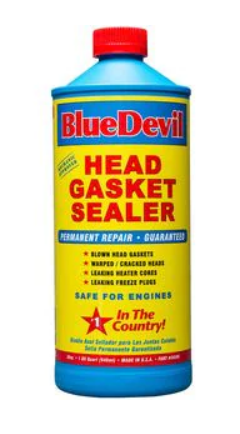Temporary head gasket repair involves using sealants to fix leaks in the gasket. This is a short-term solution and not a permanent fix.
A head gasket is a crucial component in an engine, sealing the combustion chambers and ensuring no fluids leak. Over time, head gaskets can develop leaks due to wear and tear or overheating. Temporary head gasket repair methods, such as using sealants, can provide a quick fix for minor leaks.
These products are added to the engine’s coolant system, where they work to seal cracks and holes. While this can extend the life of the gasket, it is essential to understand that such repairs are not permanent. A professional mechanic should eventually address the underlying issue to prevent more severe engine damage.
Introduction To Temporary Head Gasket Repairs
Head gasket issues can lead to major engine problems. A temporary head gasket repair can be a lifesaver. This solution helps when immediate repairs are not possible.
The Role Of The Head Gasket
The head gasket is a crucial part of the engine. It seals the engine’s combustion chamber. This seal allows the engine to build proper compression. It also prevents coolant and oil from mixing.
| Function | Importance |
|---|---|
| Seals Combustion Chamber | Ensures proper compression |
| Prevents Fluid Mixing | Avoids engine damage |
A damaged head gasket can cause serious issues. These issues include overheating and engine failure. Temporary fixes offer a quick solution until a full repair is possible.
Why Quick Fixes Are Sought
Quick fixes for head gaskets are often needed. Not everyone can afford immediate, full repairs. Temporary solutions provide a stopgap measure. This can prevent further engine damage. These fixes are also useful in emergencies.
- Cost-effective short-term solution
- Prevents further engine damage
- Useful in emergency situations
Temporary head gasket repairs can extend the life of your engine. They allow you to continue driving safely. Remember, these are not permanent solutions. A professional mechanic should handle a full repair soon.

Credit: www.youtube.com
Symptoms Of A Failing Head Gasket
A failing head gasket can cause serious damage to your car. It’s crucial to recognize the symptoms early. Here are some common signs that your head gasket might be failing.
Coolant Leaks
One of the first signs is coolant leaks. You might notice puddles under your car. The coolant can leak into the engine or outside. This can cause your engine to overheat. Check for wet spots or stains under your vehicle. Look for green, orange, or pink fluid.
Engine Overheating
Engine overheating is a clear sign of a problem. The head gasket seals the engine block and cylinder head. If it fails, coolant can’t flow properly. This causes the engine to overheat. Watch your temperature gauge. If it’s in the red, you might have a failing head gasket.
White Smoke From Exhaust
White smoke from the exhaust is another sign. This happens when coolant leaks into the cylinders. The coolant burns and creates white smoke. Check your exhaust. If you see white smoke, your head gasket might be failing.
These symptoms are crucial to recognize early. They can save your engine from further damage. Always pay attention to these signs and get your car checked immediately.
Common Temporary Solutions
Dealing with a blown head gasket can be stressful and expensive. Fortunately, there are common temporary solutions to help you manage the issue until a permanent fix is possible. Below, we explore two popular methods: coolant additives and sealant products.
Coolant Additives
Coolant additives are a quick and easy way to address minor head gasket leaks. These products are often referred to as stop-leak solutions. They work by sealing small cracks and gaps in the gasket.
- Easy to Use: Simply pour the additive into the radiator or coolant reservoir.
- Cost-Effective: These products are generally affordable, making them a budget-friendly option.
- Temporary Fix: While useful, they are not a permanent solution.
| Brand | Average Price | Effectiveness |
|---|---|---|
| Brand A | $10 | Moderate |
| Brand B | $15 | High |
Sealant Products
Sealant products are another option for temporary head gasket repair. These are more robust than coolant additives and offer a stronger seal.
- Application: Pour the sealant directly into the radiator.
- Effectiveness: Provides a stronger, more reliable seal compared to additives.
- Longevity: Lasts longer but still not a permanent fix.
It’s important to choose the right product based on your specific needs. Ensure you follow the manufacturer’s instructions for the best results.

Credit: www.reddit.com
How To Apply Sealants For A Quick Fix
Applying a sealant can be a quick fix for a temporary head gasket repair. This method is useful if you need a fast solution. Here, we guide you through the steps to make the process simple and effective.
Preparing The Engine
Proper preparation is key for a successful repair. Follow these steps to prepare your engine:
- Ensure the engine is cool to avoid burns.
- Open the hood and locate the head gasket.
- Clean the area around the head gasket using a cloth.
- Remove any debris or old sealant residue.
Application Process
Now that your engine is ready, it’s time to apply the sealant. Follow these steps:
- Shake the sealant bottle well.
- Pour the sealant directly into the radiator.
- Start the engine and let it run for 15 minutes.
- Monitor the temperature gauge to prevent overheating.
Post-application Care
After applying the sealant, some post-care steps are essential:
- Turn off the engine and let it cool.
- Check for leaks around the head gasket.
- Top up the radiator with coolant if needed.
- Drive the car for a short distance to ensure the repair holds.
Pros And Cons Of Temporary Repairs
Temporary head gasket repair can be a lifesaver in emergencies. These quick fixes can get your vehicle back on the road. Yet, they come with their own set of advantages and disadvantages. Let’s explore both sides.
Advantages Of Quick Fixes
Quick fixes offer many benefits. Here are some key points:
- Cost-effective: Temporary repairs are usually cheaper than permanent fixes.
- Time-saving: These repairs can be done quickly, often within an hour.
- Emergency solution: Ideal for getting your car to a mechanic.
- Less labor-intensive: Requires less effort compared to a full repair.
Potential Drawbacks And Risks
Despite the benefits, there are some risks involved. Consider the following:
- Short-term solution: These fixes are not permanent and will need follow-up.
- Possible engine damage: Temporary repairs can cause further damage if not done properly.
- Limited effectiveness: They may not work for severe issues.
- Hidden costs: You may end up spending more in the long run.
| Pros | Cons |
|---|---|
| Cost-effective | Short-term solution |
| Time-saving | Possible engine damage |
| Emergency solution | Limited effectiveness |
| Less labor-intensive | Hidden costs |
When To Opt For A Permanent Repair
Temporary head gasket repairs can be lifesavers. They offer quick fixes. But knowing when to opt for a permanent repair is crucial. This decision can save you time and money in the long run.
Assessing The Damage
First, you need to assess the damage. Check for signs of a blown head gasket. Common signs include white smoke, engine overheating, and coolant leaks.
| Signs of a Blown Head Gasket | Description |
|---|---|
| White Smoke | White smoke from the exhaust pipe. |
| Engine Overheating | Temperature gauge goes to red zone. |
| Coolant Leaks | Visible coolant puddles under the car. |
If you notice any of these signs, a permanent repair might be needed. Temporary fixes can only hold for so long.
Long-term Solutions
Long-term solutions provide peace of mind. They ensure your car runs smoothly. Consider these options:
- Professional Mechanic: Seek a certified mechanic for a proper repair.
- Quality Parts: Use high-quality head gasket kits.
- Regular Maintenance: Schedule regular check-ups to prevent future issues.
Each of these steps extends your engine’s life. They save you from frequent breakdowns.
Choosing permanent repairs over temporary fixes is wise. It ensures your car remains reliable and safe.
Tips For Maintaining A Healthy Head Gasket
Maintaining a healthy head gasket is crucial for your engine’s longevity. A damaged head gasket can lead to severe engine issues. Here are some effective tips to help you keep your head gasket in top shape.
Routine Maintenance
Regular maintenance is essential for a healthy head gasket. Follow these steps:
- Check coolant levels weekly.
- Ensure oil levels are optimal.
- Inspect the radiator for leaks.
- Replace old coolant every two years.
- Use the correct engine oil and coolant.
Warning Signs To Watch For
Spotting early warning signs can save your head gasket. Look for these symptoms:
- Overheating: Frequent overheating can damage the head gasket.
- White Smoke: White smoke from the exhaust indicates coolant leakage.
- Oil Contamination: Milky oil suggests coolant mixing with oil.
- Power Loss: Sudden power loss hints at gasket failure.
- Bubbles in Coolant: Bubbles in the coolant tank mean air is leaking.
By following these tips and paying attention to warning signs, you can maintain a healthy head gasket. This will ensure your engine runs smoothly and efficiently.

Credit: www.autozone.com
Understanding The Limits Of Temporary Fixes
Temporary head gasket repair can be a quick solution for minor issues. It’s important to understand its limitations. Temporary fixes are not permanent solutions. They offer a short-term relief. Knowing when to use them is crucial.
Duration Of Effectiveness
Temporary head gasket repairs usually last a few months. The exact duration varies based on driving conditions and vehicle usage. Heavy driving may shorten the repair’s lifespan. Daily commutes in heavy traffic can also affect it.
| Driving Condition | Effectiveness Duration |
|---|---|
| Light Driving | Up to 6 months |
| Moderate Driving | 3 to 4 months |
| Heavy Driving | 1 to 2 months |
When To Seek Professional Help
Some signs indicate a need for professional help. Persistent leaks, overheating, and frequent coolant loss are red flags. A mechanic can provide a permanent solution. Relying too long on a temporary fix can damage the engine.
- Persistent coolant leaks
- Engine overheating
- Frequent need to top off coolant
Temporary repairs are a stop-gap measure. They should not replace professional fixes. If you notice any severe symptoms, consult a mechanic immediately.
Frequently Asked Questions
What Is A Temporary Head Gasket Repair?
A temporary head gasket repair is a short-term fix to stop leaks. It involves using sealants to close cracks.
How Long Does A Temporary Fix Last?
A temporary head gasket repair can last a few weeks to a few months. It’s not a permanent solution.
Are Sealants Effective For Head Gasket Leaks?
Sealants can be effective for small leaks. They are not a permanent fix and won’t work for major damage.
Can I Drive With A Temporary Gasket Repair?
You can drive with a temporary repair, but it’s risky. Monitor your engine closely and fix it permanently soon.
Conclusion
Repairing a head gasket temporarily can save time and money. It’s a practical solution for short-term relief. Remember, always consult a professional for a permanent fix. Proper maintenance ensures your vehicle’s longevity and performance. Stay proactive and address issues early to avoid costly repairs.
Happy driving!


